|
Dooney Rock is located about 4 km south-east
of Sligo on the R287 to Dromahaire on the shore of Lough Gill. Views
from the top of Dooney Rock has not been compared with anywhere in the
world. And these photos of 'Fernlea, Kiltycahill' were taken from marvellous
vantage point.
Dooney Rock is a mass of carboniferous
limestone situated at the edge of Lough Gill. The rock stands majestically
in a commanding position from which the entire lake and its islands
can be viewed There is a beautiful walk through woods to a marvellous
viewing point. From the top of Dooney Rock there are views of Cottage
Island, Tobernalt, Church Island and Hazelwood. At Dooney Rock Norway
|
|
Lough Gill (or Loch Gile in Irish)
is a lake mainly situated in County Sligo, but partly in County Leitrim,
in the Republic of Ireland. It is about 8 km (5 miles) long and 2 km
(1 mile) wide and drains into the River Garavogue near Sligo Town. The
picturesque lake is surrounded by wooded hills and is popular with birdwatchers.
It is overlooked by the fortified manor house, Parke's Castle. The present
castle was built in the 1600s by Captain Robert Parke on the site of
the former stronghold of the O'Rourke (Uí Ruairc) clan. The Uí
Ruairc's ruled the area from about the 7th century (they were descended
from Sean Ferghal O Ruairc, King of Connacht around 952) up to the time
|
spruces and Scots pines together with
groups of European larch, birch, and some oak, can be found. On the
upper slopes around the rock hazel, briar, ash, beech, and hawthorn
- all developed naturally - can be foundAmong
the flora woodrush, bilberry, hearts tongue fern and holly are all
in evidence. If lucky, foxes, badgers and red squirrels can be seen.
Occasionally deer have been seen. Mute swan, duck and heron can be
seen on Lough Gill. Woodland birds include pigeon, thrush, robin,
finches, blackbird, wren and Ireland's smallest bird, the gold crest,
which is only 3.5 inches long.
Dooney Rock inspired W.B. Yeats to write the Fiddler of Dooney.
True Lovers Knot On the/ Sligo to Dromahair
Rd 200yds beyond Dooney Rock along the roadside on our right - two
old trees, 6ft 9" from the ground they are joined by one solid
branch - not
grafted or man made - called a true
lovers knot - anyone who makes a wishe at the two tree, the wish will
be granted.
Cottage Island (Beezies Island) is
one of the islands below Dooney Rock. Known locally as Beezie Island,
so named after an old lady called Beezie who lived on the island.
She was the last person to live on Lough Gill, she died in 1948, aged
over 80. She was a great old lady. She used to take out her row-boat
every Thursday and row down to Sligo to collect her old age pension
and row back again. A great friend of the fisherman. This island was
a regular port of call on Lough Gill when the lough was a very busy
place for fishing. The fisherman would 'drop in' to Beezies for a
cup of tea or a drop of anything else that was going. Sligoians recalled
her being a unique lady. She would read anything she could lay her
hands on. One gentleman who was regular visitor to this island when
Beezie was alive told she would read anything "from Buffalo Bill
to the Bible". The ruins of Beezies Cottage can still be seen
on the island. The island at one time was a
leper colony. The lepers were tended by the monks who were affiliated
to the White Canons of Lough Key in Boyle. The ruins of their monastery
can be seen on the far most tip of the island
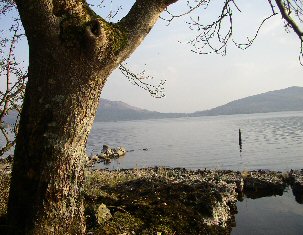
Lough Gill from the shores of Fernlea
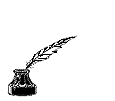
.
|
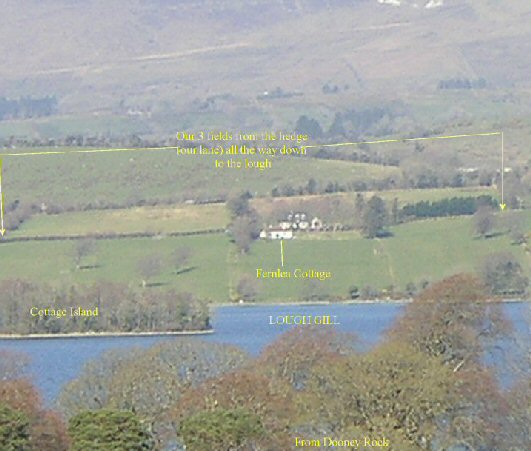
Fernlea, its fields and cottage taken
from Dooney Rock
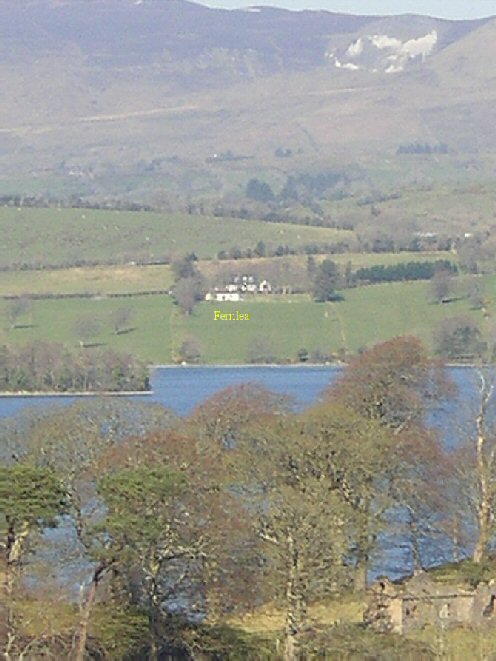
Fernlea is situated on the banks of
Lough Gill in the village of Kiltycahill. Kiltycahill means 'Cahill
Woods' and is situated in the parish of Calry (Calraidhe) meaning
descendants of Cal. Cal was the grand-uncle of Maccon, King of Ireland
in the 3rd century. He is an important person in the great history
of Connaught
Hazelwood has an older
name. Two hundred years ago it would have been known as Annagh, meaning
meeting or place of a meeting. Fernlea is situated near Annagh Bay
in Lough Gill. Annagh is mentioned in the MacFirbis gaelic poem and
also in the life of St Creellach of Kilmore Moy as Aenach Locha Gile
(meeting place of the Brigh Lake)
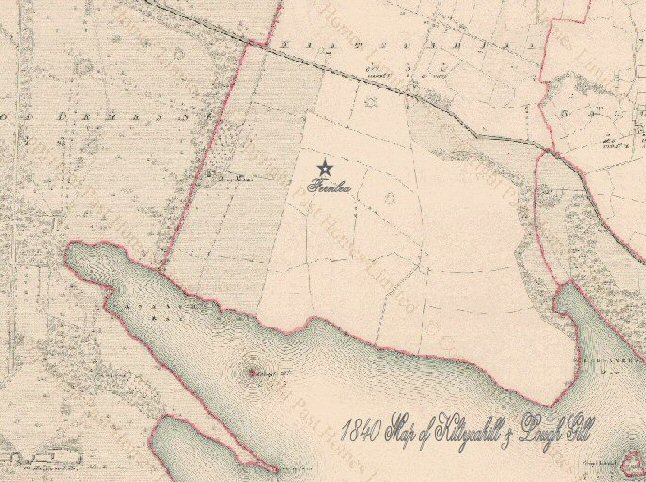
|
|
Genealogy
|
|
|
Charles Dickens Appreciation
Pages
|
|
|
Fulham FC - The Greatest
London Football Club (external web)
|
|
|
Billy Fury - The Gentle
King of Rock 'n' Roll (external web)
|
|
|
Rochester - The Historic
& Beautiful Medway City
|
|
|
Upnor Castle - 16th Elizabethan
Castle on the River Medway
|
 |
Sligo Rovers - A 'Bit O
Red' Irish football at its best (external web)
|
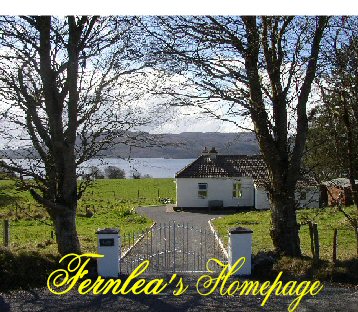

|
of Oliver Cromwell. Near Lough Gill
is Cairns Hill, a wooded hill rising to 390ft, so called because it
is capped by two cairns.According to legend, these cairns are burial
places of two old Sligo Chieftians, Romra and Omra who ruled over the
old city of Sligo, which legend would have us believe now lies under
these waters. The chieftains legends tells that Romra had a beautiful
daughter named Gile. One day Omra came and saw her charmed by her beauty
and asked her to take a stroll with him. When Romra discovered the two
lovers together, his anger and his fury was so great that he proceeded
to do battle with Omra, killing him in the battle. But during the battle
Romra himself was very badly wounded from which he later died from.
Gile in her grief from her father's death and lover, killed herself
also.
It is said from the tears of Gile's nurse-maid
Lough Gill was formed. As her name was Gile, we have the name Lough
Gill. Gile means bright, so we have Lough Gill - truly The Bright Lake.
The lake contains about 20 small islands,
including the romantic Lake Isle of Innisfree made famous in a poem
by William Butler Yeats. Half Moon Bay on the shores of Lough Gill is
part of the Hazelwood Demense. It has forest trails and a unique series
of outdoor sculptures from Irish and International artists, a quiet
picnic area and beautiful lakeside views.
Hazelwood House was built for Lieutenant General Owen Wynne in 1724.
It once belonged once to the O'Connor family of Sligo, then the Grehans,
the Wynnes and later the Percevals. The house design is by Richard Cassell
or Castle as he was later to call himself, a German architect who settled
here in the early part of the 18th c. Cassell designed some of our most
famous Irish homes. He designed Leinster House, the government house
in Dublin, Carton House, Co. Kildare; Rossborough House ; Westport House,
County Mayo ; Powerscourt Demense. Also designed the Dining Hall of
Trinity College, Dublin. in 1750.
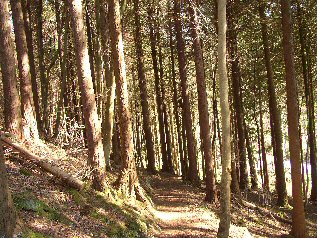
Slish Wood below Dooney Rock

|
